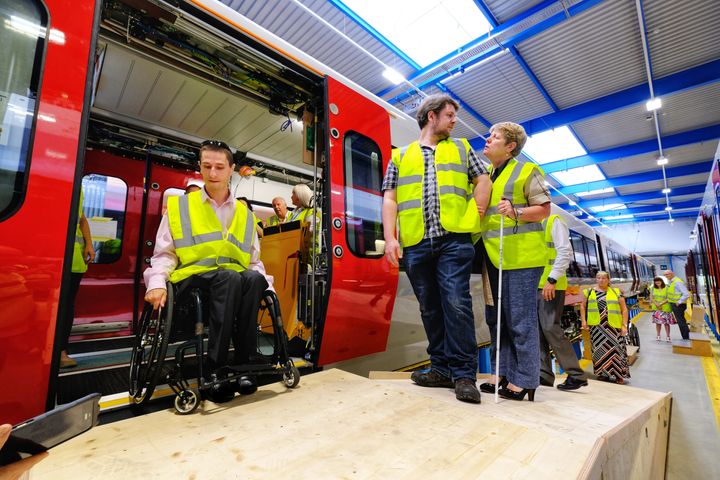
When I was first asked to be involved in the Greater Anglia New Trains project, the remit was very clear - the train design must be fit for the future disabled rail user, not just current. I was approached because of existing partnership work through my role with Essex County Council.
There were good reasons for this - the current regulations (the catchy title of PRM-TSI 2014) are the minimum that a rail carriage must offer right now. Wheelchairs and their users are getting bigger though. Their needs are more complex. That is only going to increase in the next 15-20 years.
Greater Anglia wanted to go way beyond the current regulations and all the standards it sets out. They took myself and a colleague, a visually impaired sensory trainer called Terri, to Stadler Rail in Bussnang, Switzerland, where the new trains were being designed and built, to give input to the new rail vehicles.
The trains from Stadler, built on their European model called FLIRT, are low floor. This means that level access (i.e. within 50mm between the train and the platform edge) will become possible for the first time without significant infrastructure changes. On my last check, it was around 70% of stations in Anglia.
When we were presented with the initial designs, there were some immediate obvious improvements. The buffet on the intercity services from Norwich to London will be within eye sight of the wheelchair user in the carriage. The priority seats will be closer to the doors to enable visually impaired customers to locate a seat easily. Screens and Audio announcements will be customisable, giving hearing impaired customers emergency information (such as de-train instructions or sudden journey curtailment) for the first time.
The wheelchair spaces on the regional trains were both facing the same way, which has now been changed to enable a wheelchair user to have a choice in the direction they face to travel. This will reduce travel sickness for many people.
The toilets also now offer an option for wheelchair users to use - either facing or side-transfer - with emergency buttons within reach of either direction should someone have a fall. The tap, although still sensor operated, is extended out for a visually impaired person to locate in order to wash their hands.
Reduced mobility buttons are installed to open doors, telling the hosts, guard or driver that someone with mobility requirements requires a little more time to embark or disembark.
Lastly, there’ll be a clear indicator on the front of the train as to which end the wheelchair space will be.
So as I said, rather than rely on standards, Greater Anglia have combined lived experience along with professional transport and disability expertise to build something fit for the future - to the point that, as part of my Review My Wheelchair role, we took one of the larger sized review wheelchairs with us to make sure that it can move around the train too.
I’m really proud to be part of the partnership that Greater Anglia has with it’s stakeholders - the amount of involvement that they seek from us to get things right. It’s an example to the rest of the rail industry that says “we recognise the standards - we’re using the professionals to exceed them.”
For more information about the new trains, click here.
